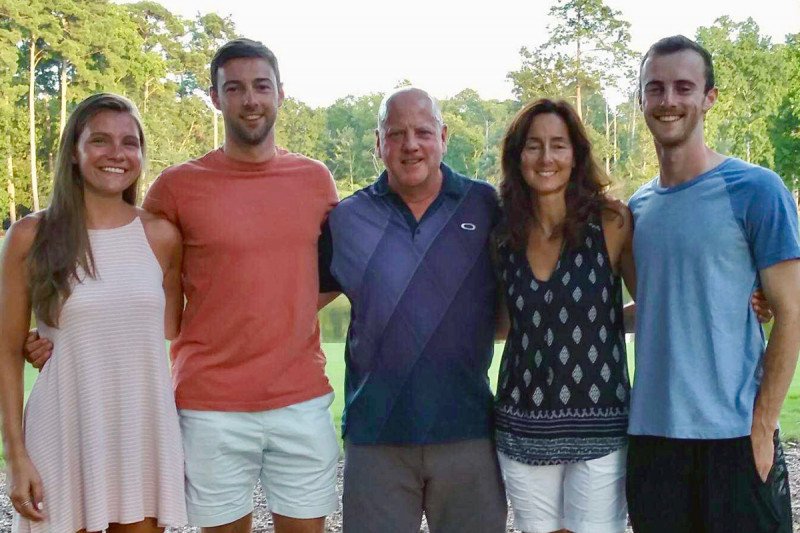
Kelly Lawlor (second from right) with her husband, Rich; her sons Kevin (orange shirt) and Dan (blue shirt); and Kevin’s girlfriend, Carol Trimble.
The first instinct of someone diagnosed with cancer is usually, “Do something. Get it out.” But that may not be best plan for everyone.
Kelly Lawlor has thyroid cancer, but for now she’s not planning to have surgery or any other treatment. Instead, the 53 year old, who works as a preschool teacher’s aide, has chosen active surveillance.
Active surveillance (also known as “watchful waiting”) is a treatment plan in which doctors closely monitor a patient’s cancer, but don’t treat it with surgery, radiation, or medication. It’s becoming increasingly common for some people who have certain types of thyroid cancer, prostate cancer, lymphoma, and other cancers.
“I feel very comfortable and confident in my choice not to have treatment,” Kelly says. “Since my tumor was first found several years ago, it has stayed small.”
Vast Experience in a Minimalist Approach
Kelly’s doctor, endocrinologist Michael Tuttle, led the creation of Memorial Sloan Kettering Cancer Center’s guidelines for active surveillance of thyroid cancer, together with head and neck surgeons Luc Morris and Richard Wong. In 2013, MSK became one of the first hospitals to offer thyroid active surveillance outside Japan, where the practice was first developed. About 500 patients with thyroid cancer are currently in active surveillance at MSK, one of the largest groups anywhere.
Dr. Tuttle says active surveillance is the “ultimate example” of a minimalist approach to treating cancer — one that’s based on a deep understanding of risk. “We’re learning that when we properly select cases for this program, these tumors really don’t change,” he says. “Only about 10% grow, and when they do, it happens very slowly. A few patients have even had their tumors naturally shrink.”
Some thyroid cancer patients in MSK’s active surveillance program have eventually needed surgery, but most of them were able to put it off for several years after their diagnosis. Studies have found patients who have surgery later do just as well long-term as those who choose to have surgery right away.
Active surveillance is an option only for the most common type of thyroid cancer, called papillary, and only for those tumors that are small and contained within one part of the thyroid gland. Other types of thyroid cancer — follicular, medullary, and Hurthle cell — can be more aggressive and require more immediate treatment.
Balancing Worry against Side Effects of Treatment
Reassuring patients that it’s safe for them not to treat their cancer can be a challenge, says MSK psychologist Jennifer Hay, who directs the Genomics, Risk, and Health Decision Making Laboratory in the Department of Psychiatry and Behavioral Science. Part of Dr. Hay’s research focuses on how patients make decisions about whether to pursue active surveillance and the psychological and psychosocial ramifications of those decisions.
“Active surveillance is a perfect example of an area where we’re starting to understand that less is more,” Dr. Hay says. “One of our goals is to help patients understand that some cancer worry and potential regrets about their decision are normal, and to balance these feelings against the real risk of side effects and complications from treatment.”
She adds, “Our research has found that this worry generally goes down over time.”
Avoiding “Extreme Measures”
For Kelly, her thyroid cancer journey started in 2006 when she noticed a large bump on the front of her neck. Needle biopsy results to determine if it was cancerous were inconclusive, and she had surgery to remove half of her thyroid gland. Tests after surgery showed that the nodule was not cancer.
A few years later, she began to experience fatigue, sleeplessness, irritability, and weight loss. She was eventually diagnosed with Hashimoto’s thyroiditis, a condition (unrelated to thyroid cancer) in which the immune system attacks the thyroid gland and prevents it from making enough thyroid hormone. Kelly had to start taking thyroid hormone medication.
When a second nodule appeared on an ultrasound in 2016, Kelly felt strongly that she didn’t want another surgery unless she absolutely had to have it. “When you have your whole thyroid removed, you have to go on medication for the rest of your life,” she says. “I knew how difficult it was to determine the right level of medication to treat my Hashimoto’s, and how awful I felt when my medication wasn’t adjusted. I felt like I wasn’t myself, and I didn’t want to feel like that again.” Her local endocrinologist determined that the new nodule was cancerous, and referred Kelly to Dr. Tuttle.
“At first I was afraid to go to Dr. Tuttle, because I was worried he was going to tell me I needed surgery,” Kelly remembers. “But he’s not an alarmist and not the kind of doctor who takes extreme measures. And the fact that he is a nationally recognized expert makes me feel good about having him take care of me.”
When Kelly started coming to MSK, she had appointments every six months, but now she needs to be seen only once a year. She has ultrasounds at MSK Bergen, which is close to her home in Northvale, New Jersey. Since the COVID-19 pandemic started, she has had her appointments with Dr. Tuttle through telemedicine, allowing her to avoid trips into Manhattan.
“I tell everyone who’s willing to listen about how happy I’ve been with my care at MSK,” Kelly says. “I know that leaving the cancer in is not the right choice for everyone, but it’s been right for me.”
- Active surveillance (also known as “watchful waiting”) is a treatment plan in which doctors closely monitor a patient’s cancer, but don’t treat it.
- It’s becoming increasingly common for certain types of cancer, including papillary thyroid cancer.
- For patients who choose this option, MSK has therapists who help patients balance feelings of worry about leaving cancer in against the risk of side effects and complications from treatment.






